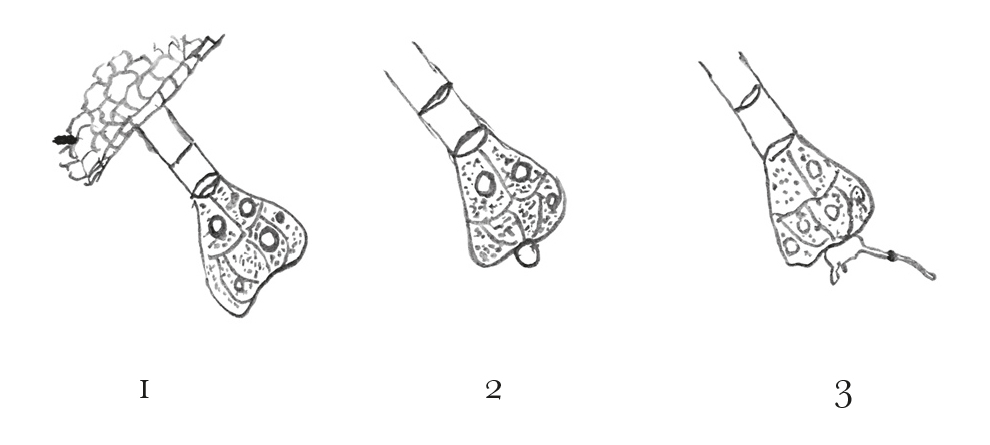To G. J. Romanes [15 June 1876 or later]1
P.S. You ask about Frank’s discovery; but if I were like you in constant communication with spirits, I shd. not care even for a jelly-fish, & this is the strongest simile I can apply to you.—2
Pray do not mention Frank’s work, as if it were to break down, it would make my mortification greater; but I am almost sure it will not break down.—3 The leaves of the teazle or Dipsacus form cups containing rain-water, in which a vast number of insects are drowned, & F. finds the cups lined with small glands on footstalks. He naturally thought that these wd. secrete digestive fluid, or more probably absorbed decaying fluid, like the quadrifid processes within the bladders of Utricularia.—4 But on placing glands (he has tried a dozen) in a weak solution of C. of Ammonia5 or in an infusion of putrid meat, he saw protruding, always from the centre of the summit of the gland, a small mass of matter,
 & on observing this he saw it send forth long filaments of the most diversified shapes, which were in constant movement. If a little alcohol (&c) is added under the slide the filaments & whole mass are quickly withdrawn within the gland as I have witnessed. There can hardly be doubt that these protoplasmic mass catch & involve particles of matter; for such particles could be seen travelling down some of the threads, or the matter of the threads was itself travelling quickly. There remains very much to observe & reobserve, for he has had all time taken up with another paper for the Q. M. Journal.6 But I can hardly doubt that we here have a highly organised plant which emits from its cells masses of protoplasm, identical with an amœba or other Protozoan, for the sake of capturing particles of dead organic matter; & this seems to me a wonderful discovery.
& on observing this he saw it send forth long filaments of the most diversified shapes, which were in constant movement. If a little alcohol (&c) is added under the slide the filaments & whole mass are quickly withdrawn within the gland as I have witnessed. There can hardly be doubt that these protoplasmic mass catch & involve particles of matter; for such particles could be seen travelling down some of the threads, or the matter of the threads was itself travelling quickly. There remains very much to observe & reobserve, for he has had all time taken up with another paper for the Q. M. Journal.6 But I can hardly doubt that we here have a highly organised plant which emits from its cells masses of protoplasm, identical with an amœba or other Protozoan, for the sake of capturing particles of dead organic matter; & this seems to me a wonderful discovery.
C.D
What a capital letter by Dr. Richardson in Nature.—7
Footnotes
Bibliography
Insectivorous plants. By Charles Darwin. London: John Murray. 1875.
Richardson, Benjamin Ward. 1876. Abstract report to ‘Nature’ on experimentation on animals for the advance of practical medicine. Nature, 15 June 1876, pp. 149–52; 22 June 1876, pp. 170–2; 29 June 1876, pp. 197–9; 20 July 1876, pp. 250–2; 3 August 1876, pp. 289–91; 17 August 1876, pp. 339–41; 31 August 1876, pp. 369–72.
Summary
Describes discovery by his son [Francis Darwin] of protoplasmic filaments extending from small glands in the leaves of Dipsacus [see Proc. R. Soc. Lond. 26 (1877): 4–8].
Letter details
- Letter no.
- DCP-LETT-10520
- From
- Charles Robert Darwin
- To
- George John Romanes
- Sent from
- unstated
- Source of text
- American Philosophical Society (Mss.B.D25.495)
- Physical description
- ALS 4pp inc
Please cite as
Darwin Correspondence Project, “Letter no. 10520,” accessed on 19 April 2024, https://www.darwinproject.ac.uk/letter/?docId=letters/DCP-LETT-10520.xml
Also published in The Correspondence of Charles Darwin, vol. 24


